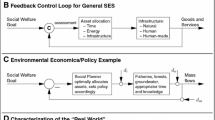Abstract
This paper analyzes nonlinear balance models of intersectorial ecological-economic interaction and proposes new approaches to solving them. The efficiency of these algorithms and possibility of using them in practice are substantiated.
Similar content being viewed by others
References
V. S. Grygorkiv, Modeling of Ecological-Economic Interaction: A Textbook [in Ukrainian], Ruta, Chernivtsi (2007).
I. M. Lyashenko, Economic-Mathematical Methods and Models of Stable Development [in Ukrainian], Vyshcha Shkola, Kyiv (1999).
M. Nedashkovskyy, “Solving of non-linear polynomial equation by branching chain fractions,” Comput. Intern. Sci. J., 2, No. 1 (2003).
M. Nedashkovskyy, “The convergence of branched continued fractions to solutions of polynomial matrix equations,” in: VIIth Intern. Conf. INTERPOR 2008 on Porous Materials: Theory and Experiment, Kazimerz Wielki Bydgoszcz Univ., Bydgoszcz-Lubostro ń, (2008), pp. 63–64.
D. I. Bodnar, Branching Continued Fractions [in Russian], Naukova Dumka, Kyiv (1986).
P. I. Bodnarchuk and V. Yu. Skorobagat’ko, Branching Continued Fractions and Their Application [in Ukrainian], Naukova Dumka, Kyiv (1974).
V. Ya. Skorobagat’ko, Theory of Branching Continued Fractions and Its Application to Computational Mathematics [in Russian], Nauka, Moscow (1983).
A. Akritas, Fundamentals of Computer Algebra with Applications [Russian translation], Mir, Moscow (1994).
J. H. Davenport, Y. Siret, and E. Tournier, Computer Algebra [Russian translation], Mir, Moscow (1991).
N. A. Nedashkovskii, “The convergence and computational stability of branching continued fractions of a certain type,” Mat. Metody Fiz.-Mekh. Polya, No. 20, 27–31 (1984).
V. V. Voevodin, Numerical Methods of Algebra [in Russian], Nauka, Moscow (1966).
V. S. Grygorkiv and A. V. Verstyak, “Forecasting a system of balanced prices on the basis of the Leontiev-Ford model,” Nauk. Visnyk L’viv. Nats. Un-ty im. Ivana Franka, Probl. Ekonom. Kibern., Special Issue 16, 61– 68 (2007).
V. S. Grygorkiv, Modelling an Economy: A Textbook [in Ukrainian], Part 2, Ruta, Chernivtsi (2006).
P. Lancaster, Theory of Matrices [Russian translation], Mir, Moscow (1978).
W. Jones and W. Thron, Continued Fractions: Analytic theory and Applications [Russian translation], Mir, Moscow (1985).
Author information
Authors and Affiliations
Corresponding author
Additional information
Translated from Kibernetika i Sistemnyi Analiz, No. 5, pp. 21–32, September–October 2011.
Rights and permissions
About this article
Cite this article
Nedashkovskiy, N.A., Kroshka, T.I. Solution of one class of nonlinear balance models of intersectoral ecological-economic interaction. Cybern Syst Anal 47, 684–694 (2011). https://doi.org/10.1007/s10559-011-9348-9
Received:
Published:
Issue Date:
DOI: https://doi.org/10.1007/s10559-011-9348-9




